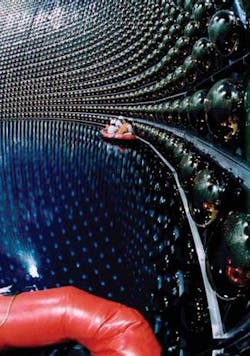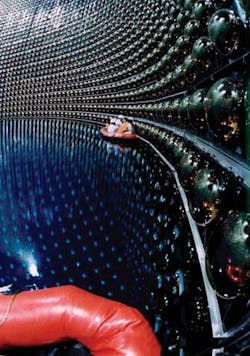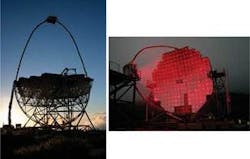PHOTOMULTIPLIER TUBES: Photomultiplier tubes present both challenge and opportunity
TONY WRIGHT AND MIKE AVERY
In the late 1920s, 30 years after the photomultiplier tube was invented, A. T. Young, the astronomer, wrote an article with the intriguing title “Photomultipliers-their cause and cure,” a title that he has also revisited in subsequent publications.1 Young might have entitled the article “their curse and cure,” as anyone with even the briefest experience with photomultipliers (PMTs) will understand. Thankfully, prospective PMT users need no longer feel the same trepidation that struck Howard Carter on first peering into the tomb of Tutankhamen. Although PMTs may be considered by some to be ancient, and despite various applications challenges, they are still the preferred devices in many scientific, medical, and industrial applications.
The first commercial application for PMTs was to read the sound stripe on early 16 mm “talking” movies. The photomultiplier chosen for this purpose was the 931A, a side-window PMT that is still manufactured. The side-window PMT has the appearance of an inverted test tube containing metal and ceramic pieces. As the name implies, the light that enters through the cylindrical glass wall is detected by an internal opaque photocathode.
The discovery by Robert Hofstadter in the 1940s of the sodium iodide scintillating crystal, with its preferred cylindrical geometry, brought about the introduction of the end-window PMT. In this form the photocathode is deposited on the inside of a flat entrance window. The next significant change in geometry was the introduction of the hemispherical PMT in the 1970s. To the delight of astrophysicists these devices offered a large detection area and a wide viewing angle. Continuous improvements in all PMT performance parameters have accompanied these fundamental changes in geometry.
Single-photon sensitivity
Photomultiplier action starts at the photocathode, where the conversion from photons to photoelectrons takes place. The largest PMT is hemispherical with a diameter of 20 in., yielding a detection area on the order of 200,000 mm2. The choice of square-millimeter units is deliberate- avalanche and p-i-n photodiodes, which sometimes rival PMTs, have detection areas of typically 1 mm2 or less, with a few devices having diameters up to about 100 mm2. The cost per square millimeter of such devices is significantly different from that of PMTs, which can be much less than a 10 cents per square millimeter, compared to $100 per square millimeter for silicon devices.
The ability of a device to detect just a few photons is critical in many applications. This is quantified using the ratio of the number of electrons generated by the light signal divided by the number of incident photons-the quantum efficiency. Photomultipliers have an advantage in the UV region of the spectrum although silicon devices are renowned for offering the highest quantum efficiency-about 80%-from 500 to 800 nm. Sensitivity of PMTs has not stood still over the years, however, with recent photocathode developments producing quantum efficiencies in the blue-green region of the spectrum bordering on 50%.
The electron multiplier is the important “other half” of the PMT, without which the benefits of the large detection area would be lost. In its most basic mode of operation, the PMT is required to amplify just one photoelectron to produce a charge of sufficient magnitude for commercial electronic circuitry to encode. When the 1.6 × 10-19 C charge of an electron is amplified by a factor of 107 the resulting charge is 1.6 pC, and integrating this on a 1 pF capacitor results in a voltage signal of 1 V. This is a very small capacitor, but this basic example gives a good idea of what is required of a detector capable of detecting a single photon.
Certain PMTs have a gain capability of up to 109, which is more than sufficient to allow single-photon events to be seen on an oscilloscope. High gain is of no use unless it extends over a sufficiently wide bandwidth, however, and the detector is relatively noiseless. Some of the electron multipliers used in PMTs have bandwidths extending to the gigahertz region, which, together with their high gain capability, leads to unsurpassed performance.
Unique PMT applications
A typical example of an application unique to PMTs is the Nobel Prize-winning Super-K neutrino detector in Japan. Everything about this scientific experiment is awesome: the tank that holds the detector liquid is 34 m in diameter by 40 m high. A total of 13,035 PMTs, each of 20 in. diameter and with a total photocathode area in excess of 2000 m2, observes the pure water for very rarely occurring interactions, each of which gives out very little light (see Fig. 1).
Another example is the MAGIC aerobic telescope, which looks for neutrino interactions in the Earth’s atmosphere. The energy of the particle and its direction are determined from the total light detected and its path across the sensitive area of the dish (see Fig. 2). Neither of these two experiments is kind to the PMTs. Those used in the Super-K are immersed in purified water and thus have to withstand the water pressure as well as a corrosive environment. The cluster of PMTs used in the aerobic telescopes operates in starlight. While it appears relatively dim for the human eye, it is very intense for a PMT. For good viewing, telescopes of this type are often located at high altitude and in desert conditions, which also lead to wide temperature swings.
Detectors made of glass are also often unsuitable for applications in harsh environments. One example is oil-well logging, which can require tubes to operate at temperatures of up to 200°C under extreme vibration. The most rugged tubes for this application are made from metal and ceramic rings with a sapphire input window. At the other extreme of temperature, there are scientific experiments working in the Antarctic ice, and others in which the PMTs are immersed in liquid argon.
“Homeland Security” presents the latest challenge for PMTs, which are used for the detection of bomb-making isotopes or substances for conventional explosives. The challenge lies in being able to do it quickly and efficiently. The latest systems achieve high throughput by using a strong source of probing radiation, often derived from a linear accelerator (LINAC) configured to produce neutrons. Tell-tale gamma lines signal the presence of contraband. Accurate and fast identification relies on the use of massive thalium-doped sodium iodide crystals and PMTs that offer good resolution at high count rates.
Alternatives
What about other types of PMTs? The hybrid PMT is a vacuum device in which the dynode structure (the multiplier) is replaced with a silicon detector, usually pixilated. The resulting device offers single-photon detection and imaging. Operation is possible in high magnetic fields. Large detection areas, similar to that of conventional PMTs, can be achieved. The downside is that these detectors currently cost as much as 20 times that of the parent device.
Interesting developments have taken place in the last five years concerning the silicon PMT (SiPM), which is a multipixel silicon photodiode with a large number of micropixels combined on a common substrate and working into a common load. Each pixel is operated in Geiger mode with a gain of 106. Provided that the light can be spread over many pixels, the SiPM offers excellent resolution of multiphoton signals. While these detectors exhibit high quantum efficiency, immunity to magnetic fields, and good resolution, the active area offered by the pixels is only 25% to 50% of the geometrical area. Their sensitivity in the green-to-red region of the spectrum exceeds that offered by conventional PMTs, however, making up for the reduced sensing area.
Gas-filled detectors, (GEMs), offering properties similar to a PMT, are beginning to show promise as large-area, flat detectors of sufficient gain to detect single photons. The “holy grail” is a thin detector of “A4” geometry that would have applications in chest-x-ray machines and in many scientific experiments.
Photomultipliers have been “on the verge of extinction” for the past 30 years. They continue to thrive, however, because they offer large detection area with minimal dark counts, high and relatively noiseless gain, fast timing capability, lowest cost per unit area of detection, and the ability to operate in hostile environments.
Although half a million PMTs are produced annually, they can still present problems for new users. The availability of supporting literature from manufacturers is helpful, but the incorporation of PMTs into light-detector modules is playing a major role in enabling broader use. As the name implies, a light-detector module is a complete detector configured for applications such as photon counting, measuring slowly varying light signals, or pulse counting. Such modules can include a high-voltage supply, factory adjusted to an appropriate operating point. Many photon-counting modules use only a 5 V power supply and have a RS232 or USB interface.
REFERENCE
1. A.T. Young, “Photomultipliers, their causes and cures,” Chapter 1, Methods of Experimental Physics: Astrophysics, N. Carleton ed., Vol. 12, Academic (1974).
TONY WRIGHT is chief scientist and MIKE AVERY is West Coast (U.S.) sales manager for Electron Tubes, Bury Street, Ruislip, Middlesex, HA4 7TA, England; e-mail: [email protected]; www.electron-tubes.com. Electron Tubes is a division of the newly formed ET Enterprises (ETEL) and was previously the photomultiplier business of Electron Tubes (ETL).


